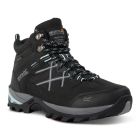When to Replace Your Walking Boots: A Comprehensive Guide
Author
Hiking shoes are essential gear for outdoor enthusiasts, providing support, comfort, and traction on various terrains. However, like all equipment, hiking boots have a lifespan and must be replaced when they start showing signs of wear. In this informative guide, we will explore the key indicators that signal it's time for new hiking shoes, a simple "press test" to check your boots' condition, and general mileage guidelines for replacement.

The "Press Test" for Your Hiking Boots:
A quick "press test" allows you to assess your hiking boots' condition. Follow these steps:
Press the outsole of your boot upward with your thumb, mimicking the flexing and compression during hiking.
Observe the midsole for cracks or strong compression lines. Fine lines indicate good condition, while cracks or no compression signal a need for replacement.
Signs You Need to Replace Your Hiking Shoes:
Frayed or Worn Laces:
Frayed or worn laces indicate that your hiking boots are reaching the end of their serviceable life. The constant tightening and loosening of laces wear them down over time, affecting the overall fit and support of the shoes.
Cracked Midsole or Compression Lines:
A cracked midsole or visible compression lines are definite signs that your shoes need retirement. The midsole's structural integrity is compromised, leading to a lack of cushioning and support during long hikes.
Loose Eyelets:
Loose eyelets make proper lacing difficult, diminishing the shoes' comfort and support on the trail. If you notice this issue, it's time to start looking for a replacement.

Worn Out Insoles and Ankle Support:
Examine the insoles for cracks and the ankle collar for misshapen cushioning or a loose fit. Worn-out insoles and ankle support significantly reduce comfort and stability during hikes.
- Worn Outsole Tread:
Worn tread on the outsoles of your hiking shoes affects traction, jeopardising your stability on various terrains. Replacing the shoes ensures safety on the trail.
Increased Discomfort:
If you experience blisters, foot, joint, or back pain, or "hot spots" that weren't present when your shoes were new, it's a clear indication that your hiking boots are too worn out for further use.
General Mileage Guidelines for Replacing Hiking Shoes:
On average, quality hiking boots and trail shoes can endure 500 to 1000 miles (805 to 1610 km). However, the actual mileage depends on various factors such as hiker weight, terrain, shoe type, and maintenance.
Heavier hikers and high-mileage hikers will experience quicker wear and tear on their shoes.
Proper care, cleaning, and drying after each trip can extend the lifespan of your boots.
The brand and type of hiking boots also play a significant role in their durability.
Conclusion:
Knowing when to replace your hiking boots is vital for ensuring a safe and enjoyable hiking experience. By recognizing the signs of wear and performing a simple "press test," you can determine whether it's time to invest in a new pair of hiking shoes. Additionally, following general mileage guidelines and considering factors like hiker weight, terrain, and shoe care will help you make informed decisions and extend the life of your hiking boots. Be sure to choose quality brands when purchasing your hiking footwear to ensure durability and performance on your outdoor adventures.
-
 Regatta Womens Samaris III Walking Boots£41.69 to £60.00RRP £120.00 Save Up To £78.31
Regatta Womens Samaris III Walking Boots£41.69 to £60.00RRP £120.00 Save Up To £78.31
Author
Categories
- Sport (28)
- Product Reviews (3)
- Team Outdoor Look (7)
- Mike Wild (2)
- Mike Payton (2)
- Suse Hammond-Pears (3)
- Snowboarding (12)
- Latest Offers (105)
- Shop Talk (1)
- Competitions (7)
- Walking (413)
- Lifestyle Fashion (8)
- Travel (86)
- Kit Guides (176)
- Workwear Clothing (6)
- Safety Workwear (4)
- Health/Fitness (289)
- Skiing (91)
- Great Outdoors (1316)
- Cycling (92)
- January 2025
- December 2024
- November 2024
- October 2024
- September 2024
- August 2024
- July 2024
- June 2024
- May 2024
- April 2024
- March 2024
- February 2024
- January 2024
- December 2023
- November 2023
- October 2023
- September 2023
- August 2023
- July 2023
- June 2023
- May 2023
- April 2023
- March 2023
- February 2023
- January 2023
- December 2022
- November 2022
- October 2022
- September 2022
- August 2022
- July 2022
- June 2022
- May 2022
- April 2022
- March 2022
- February 2022
- January 2022
- December 2021
- November 2021
- October 2021
- September 2021
- August 2021
- July 2021
- June 2021
- May 2021
- April 2021
- March 2021
- February 2021
- January 2021
- December 2020
- November 2020
- October 2020
- September 2020
- August 2020
- July 2020
- June 2020
- May 2020
- April 2020
- March 2020
- February 2020
- January 2020
- December 2019
- November 2019
- October 2019
- September 2019
- August 2019
- July 2019
- June 2019
- May 2019
- April 2019
- March 2019
- February 2019
- January 2019
- December 2018
- November 2018
- October 2018
- September 2018
- August 2018
- July 2018
- June 2018
- May 2018
- April 2018
- March 2018
- February 2018
- January 2018
- December 2017
- November 2017
- October 2017
- September 2017
- August 2017
- July 2017
- June 2017
- May 2017
- April 2017
- March 2017
- February 2017
- January 2017
- December 2016
- November 2016
- October 2016
- September 2016
- August 2016
- July 2016
- June 2016
- May 2016
- April 2016
- March 2016
- February 2016
- January 2016
- December 2015
- November 2015
- October 2015
- September 2015
- August 2015
- July 2015
- June 2015
- May 2015
- April 2015
- March 2015
- February 2015
- January 2015
- December 2014
- November 2014
- October 2014
- September 2014
- August 2014
- July 2014
- June 2014
- May 2014
- April 2014
- March 2014
- February 2014
- January 2014
- December 2013
- November 2013
- October 2013
- September 2013
- August 2013
- July 2013
- June 2013
- May 2013
- April 2013
- March 2013
- February 2013
- January 2013
- December 2012
- November 2012
- October 2012
- September 2012
- August 2012
- July 2012
- June 2012
- May 2012
- April 2012
- March 2012
- February 2012
- January 2012
- December 2011
- November 2011
- October 2011
- September 2011
- August 2011
- May 2010
- April 2010
- March 2010
- February 2010
- January 2010
- November 2009
- October 2009
- September 2009


Submit a Comment